Department store chain Kohl’s (NYSE:KSS) beat analysts' expectations in Q4 FY2023, with revenue down 1% year on year to $5.96 billion. It made a GAAP profit of $1.67 per share, improving from its loss of $2.48 per share in the same quarter last year.
Kohl's (KSS) Q4 FY2023 Highlights:
- Revenue: $5.96 billion vs analyst estimates of $5.77 billion (3.2% beat)
- EPS: $1.67 vs analyst estimates of $1.28 (30.8% beat)
- Full year guidance: Same store sales growth of 1% year on year was better than expectations, but EPS of $2.40 missed expectations
- Gross Margin (GAAP): 35.2%, up from 26.2% in the same quarter last year
- Free Cash Flow of $707 million, up 15.1% from the same quarter last year
- Same-Store Sales were down 4.3% year on year (miss vs. expectations of down 3.2% year on year)
- Market Capitalization: $3.01 billion
Founded as a corner grocery store in Milwaukee, Wisconsin, Kohl’s (NYSE:KSS) is a department store chain that sells clothing, cosmetics, electronics, and home goods.
As the name suggests, a department store offers a wide variety of merchandise organized into different departments or sections. Before the introduction of department stores in the 19th century, consumers would have to visit three different stores to buy a pair of shoes, nail polish, and towels for the home.
Today, the core Kohl’s customer is a middle-income woman shopping for herself and for her family. This customer can find prominent brands such as Nike, Levi’s, Keurig, and Samsung in a typical Kohl’s store or on its e-commerce site. Stores tend to be between 80,000 and 100,000 square feet and located in strip shopping centers rather than the traditional suburban malls that many department stores anchor. Common departments in a Kohl’s store include women’s/men’s/children’s apparel, beauty/cosmetics, and electronics. Additionally, Kohl's has an e-commerce presence which was launched in 2001 and today enables both online orders to be shipped to a customer’s home as well as buy online for store pickup.
Since the introduction of e-commerce, Kohl’s and peers have faced increased competition. Evolving specialty retailers and developments such as fast fashion have also pressured the department store model.
Department Store
Department stores emerged in the 19th century to provide customers with a wide variety of merchandise under one roof, offering a convenient and luxurious shopping experience. They played an important role in the history of American retail and urbanization, and prior to department stores, retailers tended to sell narrow specialty and niche items. But what was once new is now old, and department stores are somewhat considered a relic of the past. They are being attacked from multiple angles–stagnant foot traffic at malls where they’ve served as anchors; more nimble off-price and fast-fashion retailers; and e-commerce-first competitors not burdened by large physical footprints.
Department or general merchandise retail competitors include Macy’s (NYSE:M), Nordstrom (NYSE:JWN), and Dillard’s (NYSE:DDS).Sales Growth
Kohl's is one of the larger companies in the consumer retail industry and benefits from economies of scale, enabling it to gain more leverage on fixed costs and offer consumers lower prices.
As you can see below, the company's revenue has declined over the last four years, dropping 3.3% annually as it failed to grow its store footprint meaningfully and observed lower sales at existing, established stores.
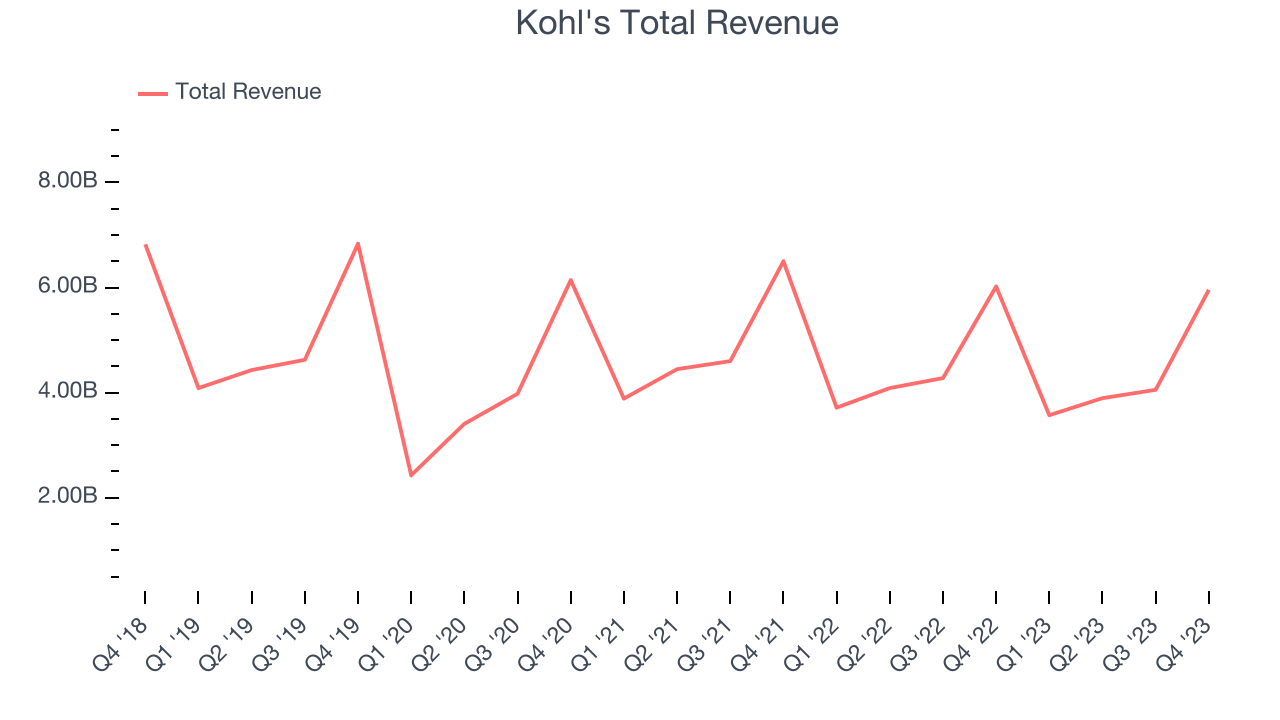
This quarter, Kohl's revenue fell 1% year on year to $5.96 billion but beat Wall Street's estimates by 3.2%. Looking ahead, Wall Street expects revenue to decline 4.6% over the next 12 months, a deceleration from this quarter.
Same-Store Sales
A company's same-store sales growth shows the year-on-year change in sales for its brick-and-mortar stores that have been open for at least a year, give or take, and e-commerce platform. This is a key performance indicator for retailers because it measures organic growth and demand.
Kohl's demand has been shrinking over the last eight quarters, and on average, its same-store sales have declined by 5.7% year on year. This performance is quite concerning and the company should reconsider its strategy before investing its precious capital into new store buildouts.
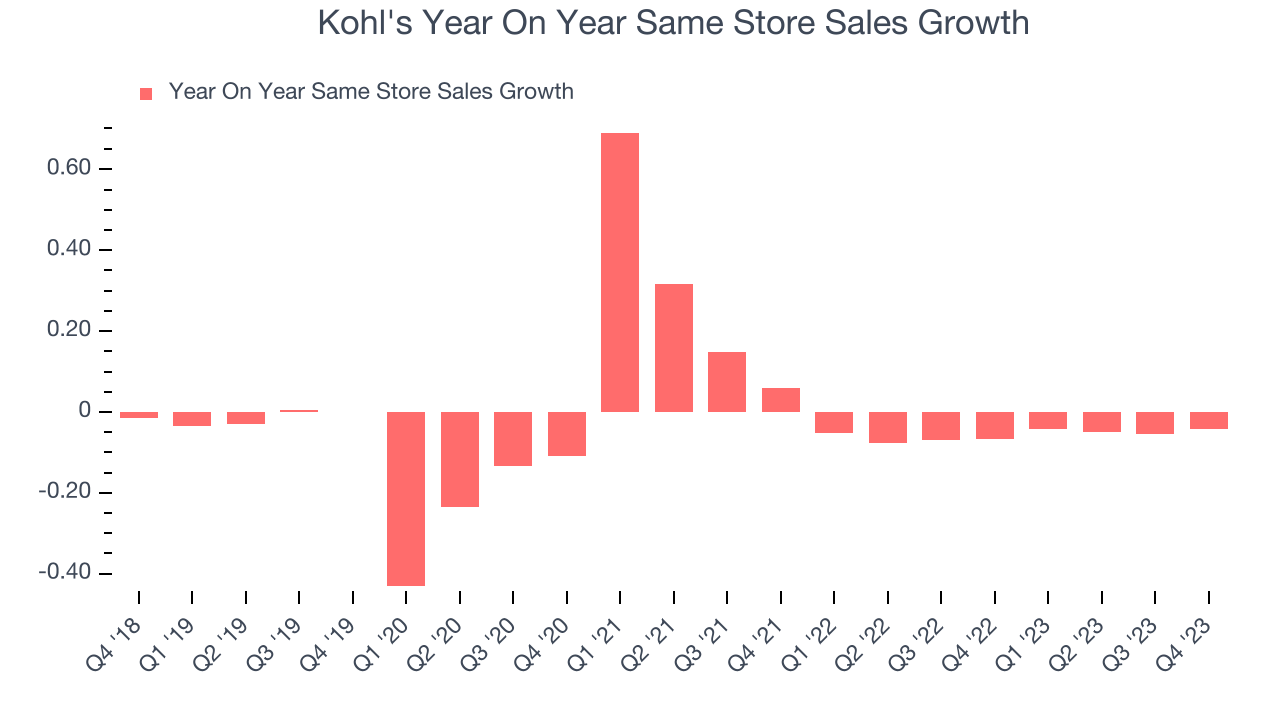
In the latest quarter, Kohl's same-store sales fell 4.3% year on year. This decrease was a further deceleration from the 6.6% year-on-year decline it posted 12 months ago. We hope the business can get back on track.
Gross Margin & Pricing Power
We prefer higher gross margins because they not only make it easier to generate more operating profits but also indicate product differentiation, negotiating leverage, and pricing power.
Kohl's unit economics are higher than the typical retailer, giving it the flexibility to invest in areas such as marketing and talent to reach more consumers. As you can see below, it's averaged a decent 38.3% gross margin over the last eight quarters. This means the company makes $0.38 for every $1 in revenue before accounting for its operating expenses.
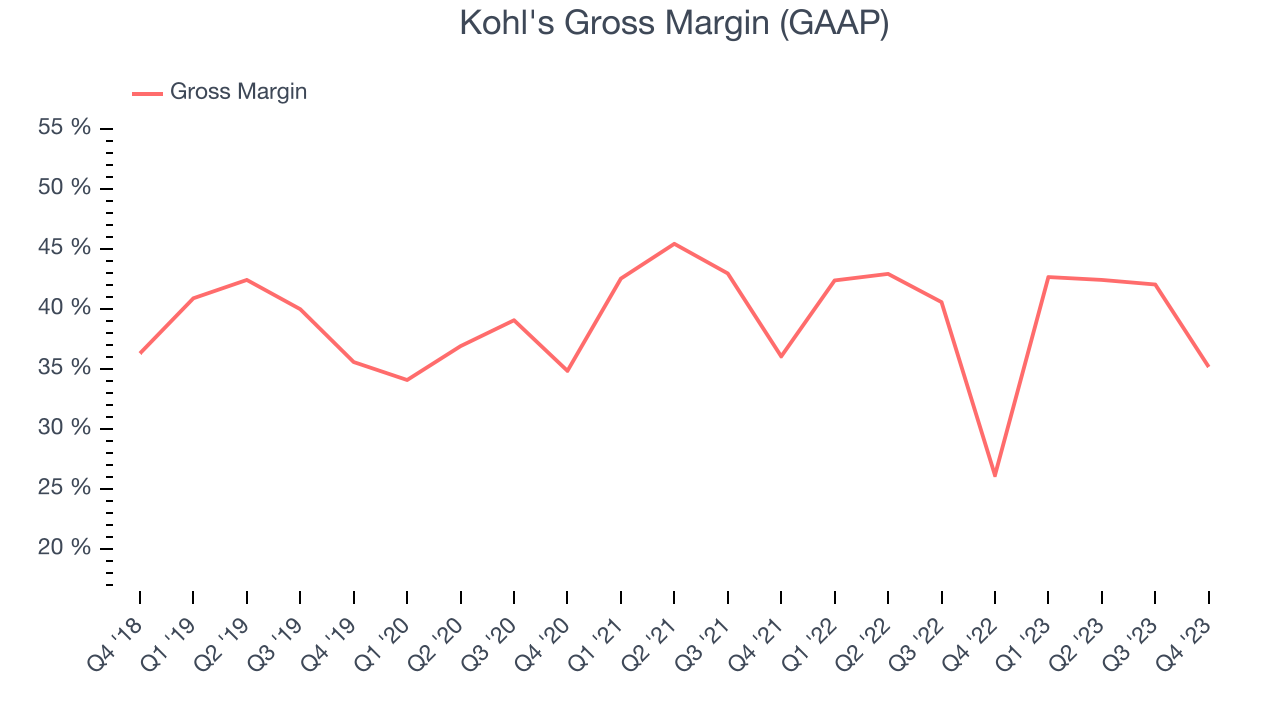
Kohl's produced a 35.2% gross profit margin in Q4, marking a 9 percentage point increase from 26.2% in the same quarter last year. This margin expansion is a good sign in the near term. It shows the company increased its pricing power, and if this trend continues, it could signal a less competitive environment where it has more negotiating leverage and stable input costs (such as distribution expenses to move goods).
Operating Margin
Operating margin is a key profitability metric for retailers because it accounts for all expenses keeping the lights on, including wages, rent, advertising, and other administrative costs.
This quarter, Kohl's generated an operating profit margin of 5%, up 10 percentage points year on year. This increase was encouraging, and we can infer Kohl's was more disciplined with its expenses or gained leverage on fixed costs because its operating margin expanded more than its gross margin.
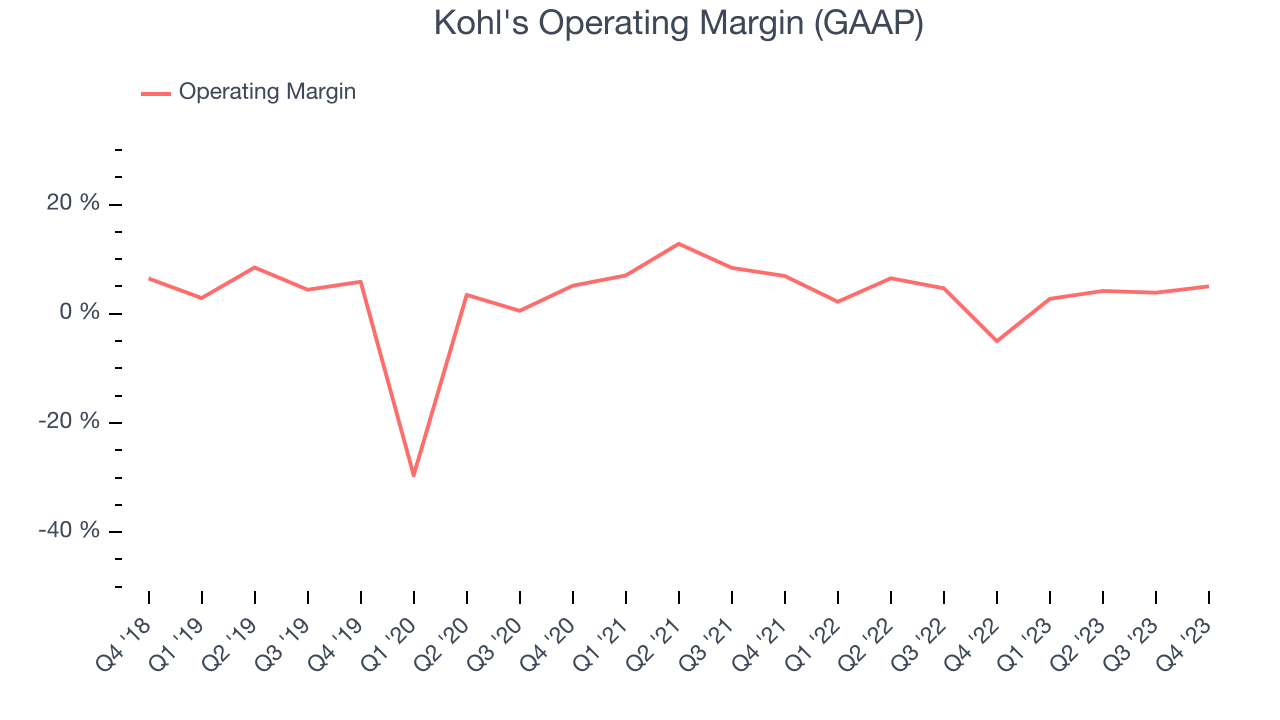 Zooming out, Kohl's was profitable over the last two years but held back by its large expense base. Its average operating margin of 2.7% has been paltry for a consumer retail business. However, Kohl's margin has improved, on average, by 2.7 percentage points year on year, an encouraging sign for shareholders. The tide could be turning.
Zooming out, Kohl's was profitable over the last two years but held back by its large expense base. Its average operating margin of 2.7% has been paltry for a consumer retail business. However, Kohl's margin has improved, on average, by 2.7 percentage points year on year, an encouraging sign for shareholders. The tide could be turning.EPS
Earnings growth is a critical metric to track, but for long-term shareholders, earnings per share (EPS) is more telling because it accounts for dilution and share repurchases.
In Q4, Kohl's reported EPS at $1.67, up from negative $2.48 in the same quarter a year ago. This print beat Wall Street's estimates by 30.8%.
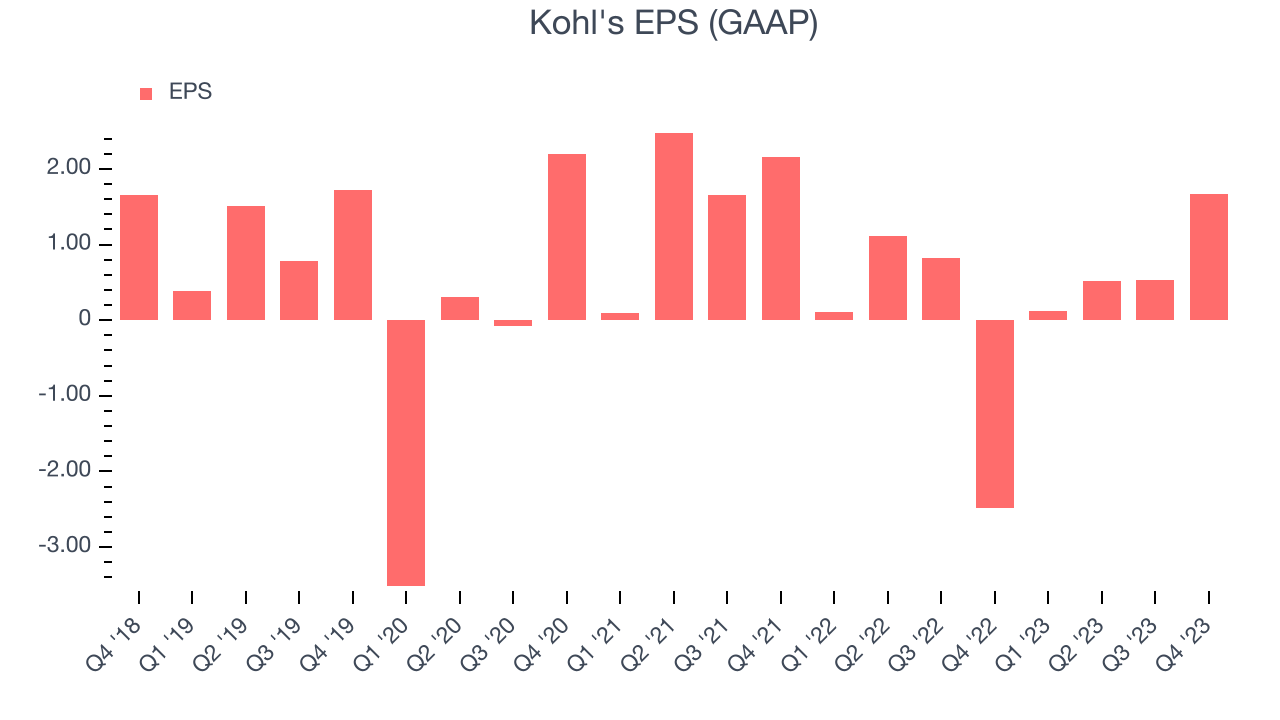
Between FY2019 and FY2023, Kohl's adjusted diluted EPS dropped 35.2%, translating into 10.3% annualized declines. In a mature sector such as consumer retail, we tend to steer our readers away from companies with falling EPS. If there's no earnings growth, it's difficult to build confidence in a business's underlying fundamentals, leaving a low margin of safety around the company's valuation (making the stock susceptible to large downward swings).
Wall Street expects Kohl's to continue performing poorly over the next 12 months, with analysts projecting an average 9.8% year-on-year decline in EPS.
Cash Is King
Although earnings are undoubtedly valuable for assessing company performance, we believe cash is king because you can't use accounting profits to pay the bills.
Kohl's free cash flow came in at $707 million in Q4, up 15.1% year on year. This result represents a 11.9% margin.
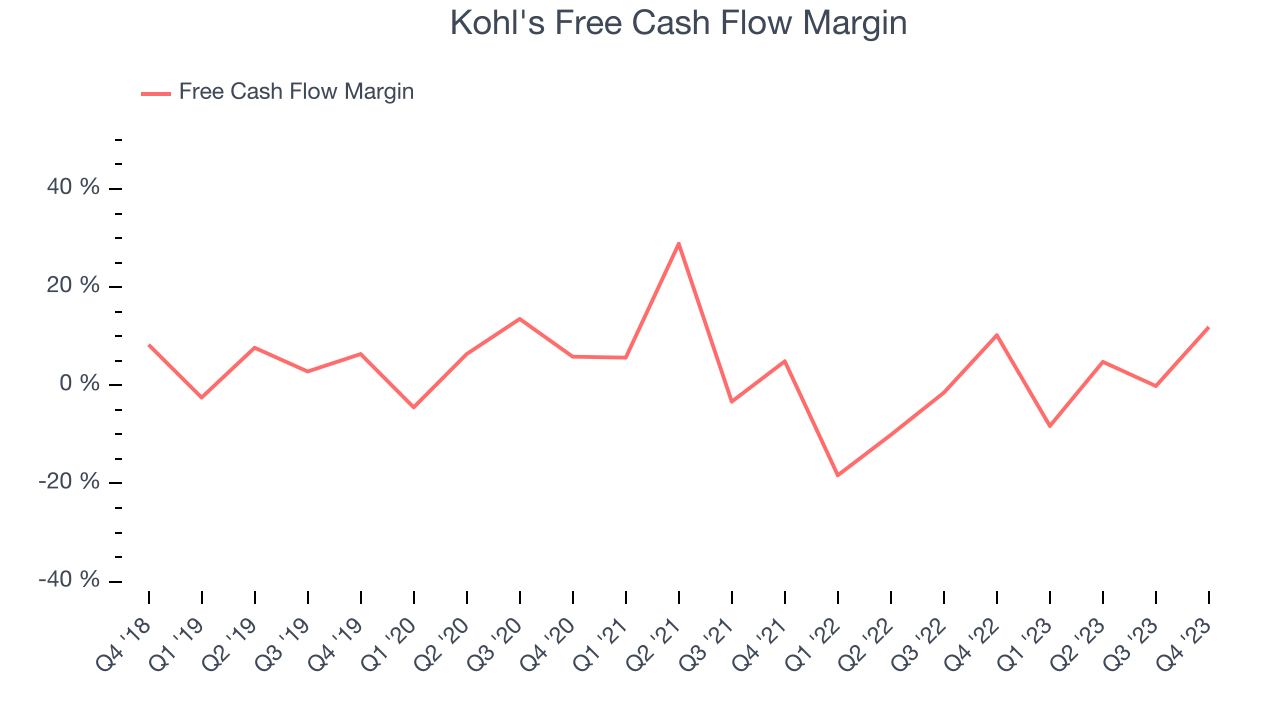
Over the last eight quarters, Kohl's has shown mediocre cash profitability, putting it in a pinch as it gives the company limited opportunities to reinvest, pay down debt, or return capital to shareholders. Its free cash flow margin has averaged 0.1%, subpar for a consumer retail business. However, its margin has averaged year-on-year increases of 6.4 percentage points, a great result that should improve its prospects.
Return on Invested Capital (ROIC)
EPS and free cash flow tell us whether a company was profitable while growing revenue. But was it capital-efficient? A company’s ROIC explains this by showing how much operating profit a company makes compared to how much money the business raised (debt and equity).
Kohl's five-year average ROIC was 8.3%, somewhat low compared to the best retail companies that consistently pump out 25%+. Its returns suggest it historically did a subpar job investing in profitable business initiatives.
The trend in its ROIC, however, is often what surprises the market and drives the stock price. Over the last two years, Kohl's ROIC averaged 4.4 percentage point increases each year. This is a good sign and we hope the company can continue to improving.
Key Takeaways from Kohl's Q4 Results
We were impressed by how significantly Kohl's blew past analysts' EPS expectations this quarter. We were also excited its gross margin outperformed Wall Street's estimates. On the other hand, its full-year earnings forecast missed analysts' expectations. Overall, we think this was a really good quarter that should please shareholders. The stock is flat after reporting and currently trades at $27.26 per share.
Is Now The Time?
Kohl's may have had a good quarter, but investors should also consider its valuation and business qualities when assessing the investment opportunity.
We cheer for all companies serving consumers, but in the case of Kohl's, we'll be cheering from the sidelines. Its revenue has declined over the last four years, and analysts expect growth to deteriorate from here. And while its popular brand makes consumers more likely to purchase its products, the downside is its shrinking same-store sales suggests it'll need to change its strategy to succeed. On top of that, its relatively low ROIC suggests it has struggled to grow profits historically.
Kohl's price-to-earnings ratio based on the next 12 months is 10.5x. While the price is reasonable and there are some things to like about Kohl's, we think there are better opportunities elsewhere in the market right now.
Wall Street analysts covering the company had a one-year price target of $26.21 per share right before these results (compared to the current share price of $27.26).
To get the best start with StockStory, check out our most recent stock picks, and then sign up to our earnings alerts by adding companies to your watchlist here. We typically have the quarterly earnings results analyzed within seconds of the data being released, and especially for companies reporting pre-market, this often gives investors the chance to react to the results before the market has fully absorbed the information.
